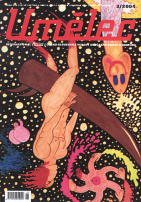| Zeitschrift Umělec 2004/3 >> Sasnal | Übersicht aller Ausgaben | ||||||||||||
|
|||||||||||||
SasnalZeitschrift Umělec 2004/301.03.2004 Andrew Hunt | geschichte | en cs |
|||||||||||||
|
Wilhelm Sasnal
Camden Arts Centre, London 25 June to 22 August 2004 With sixteen paintings shown in a precarious sequence, first impressions of Wilhelm Sasnal’s exhibition at Camden Arts Centre were of its filmic and fragmented sense of narrative. In some respects this came as no surprise; the paintings, contained within a large rectangular room snapped from one scene to another, and presented a complex index of imagery. Indicative of Sasnal’s style, the installation also sensitively served to identify a practice that at once includes figurative, abstract and graphic devices united by the spectre of the artist’s chosen photographic source material. Certain works initially stood out from the group, one of which was, Untitled (Kill This Love) (2003). Smears of black, grey and white paint cover a small canvas, parts of which seem to be trying to represent something with wispy tangled brush marks. It’s only after a second or third glance that one sees the image of a dog – perhaps an Alsatian – with its head cropped at the top of the picture. Two other works speak in a totally different manner. Untitled (Church) (2003) shows a church’s wrought iron gate through simple black linear marks on a white background. In a massive contradiction, loose marks, drips and dribbles, somehow manage to make a tight geometric image disintegrate before our eyes. Untitled (Sulphur) (2003), uses a graphic style that paradoxically and deliberately disrupts any anchor in the real. Appearing inscribed onto another large white monochrome ground, spidery text emerges or disappears (depending on which way you look at it) through a linear window towards the back of beyond. With this being Sasnal’s first solo exhibition in a public institution in the UK, coming not long after his exhibition at Sadie Coles HQ in 2003, it’s evident how his practice has been opened up by the influence of curators such as Adam Szymczyk and the increasingly international profile of Warsaw’s Foksal Gallery Foundation. It’s also interesting that recent critical response to his work has been almost entirely positive, and seems to dwell on an economy of ‘authentic’ marginalism, one connected with Sasnal’s background and the simulated plasticity of his work. Firstly Sasnal’s paintings are said to contain an indirect relationship to Polish history—the artist was born in the early 70s and, where social and political upheavals have changed his country dramatically, there’s supposedly an attempt in his work to deal with erasure and the rescue of collective memory. Secondly, there’s been a more philosophical context hinted at through the work’s exclusively photographic source material and its painted interpretation; of the free association created within the gap between the two colliding visual languages and their material existences. In one sense, Untitled (2003), represents this contradiction quite successfully. The painting shows a door with a chain hanging around the handle. Sasnal has commented that he’s not interesting in imposing any reading on this picture but is interested, instead, in pleasure for the viewer, in the gap of interpretation that is enforced by the mediation of opposing styles. Unfortunately, there’s an uncomfortable element to the heterogeneity of Sasnal’s paintings and the sheer proliferation of his work. The traditional and in some senses passé disruption of modernist painting (the implication of risk, where a mono-style is seriously dislocated) in reality enables the artist to cover and mask his work from a certain type of failure. Sure, both the imagery and materiality of Sasnal’s work represents a reflection of his country’s social and political context, but it also reflects a more straightforward economic concern for the artist. In reality, one of the successful things about Sasnal is that he sometimes manages to find alternatives to dominant modes of painted photographic representation such as those of Gerhard Richter and Luc Tuymans. This happens in small works such as, Untitled (2004), where a clumsy half-baked, yet somehow tight and effective portrait of a woman shows a different material response to photographic reality, and in, Untitled (Anka) (2004), a loose but graphic representation of another female figure, shown in perspective from below. Rendered in modernist flat black and white, this second work is part fashion image, part arrogant posturing and begins to identify a sense of the artist’s interest in alternative or oppositional culture. This is only hinted at by the style of the woman’s clothing and the loose rendering of the paint, but is more evident in, Untitled (Sweat) (2002), a painting that transcribes salt marks left by sweat on a T-shirt that Sasnal wore to a Sonic Youth concert. To complicate matters, the original T-shirt was also stretched, injecting the work with a strange energy and subjectivism. This example of a playful disruption to the authenticity of imagery and experience is equalled by Sasnal’s capacity for stylistic experimentation. Untitled (t&r&a, inside the snake) (2004), one of the largest works in the exhibition, stood out as being successful in its graphic form of abstraction. Painted on raw canvas, washes of slight colour fill eccentric circles that seem to envelop its viewer, becoming at once shallow but overpowering in its physicality. At worst, Sasnal’s paintings are a safe bet and he presents a tight aesthetic that becomes diluted the more it tries to cover every angle, but at its best, he shows us an enthusiasm for an array of cultural influences that successfully play with important new forms of representation.
01.03.2004
Empfohlene Artikel
|
|||||||||||||



-2004.jpg.thumb.png)





Kommentar
Der Artikel ist bisher nicht kommentiert wordenNeuen Kommentar einfügen